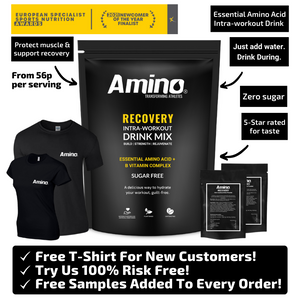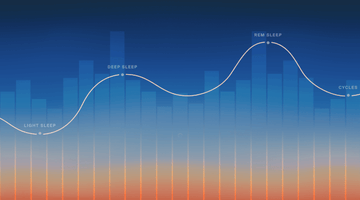When it comes to fitness and muscle growth, nutrition plays a crucial role. Proper nutrition ensures that we have adequate energy and resources to recover after intense workouts. Proteins are essential macronutrients that are necessary for building and repairing muscle tissue.
When it comes to building muscle and maintaining a healthy body, many people turn to protein supplements. However, there are different types of protein supplements available, and it's important to know which one is right for you. In this article, we'll compare two popular options: Essential Amino Acids (EAAs) and whey protein.
In this blog post, we will be discussing the basics of these two protein supplements and how they differ from each other. Our aim is to help you choose the best supplement according to your needs.
Essential Amino Acids (EAAs)
What are EAAs?
Essential Amino Acids (EAAs) are the building blocks of proteins. There are 20 types of amino acids, out of which 9 are essential amino acids that cannot be synthesized by the human body. These amino acids must be obtained through dietary sources or supplements. EAA supplements contain all nine essential amino acids in a balanced and precise amount.
Role of EAA in muscle growth and repair:
EAA supplements are essential for muscle growth and recovery. They play a crucial role in the process of muscle protein synthesis, which is the creation of new muscle proteins. When we train our muscles, we create microscopic tears in muscle fibers. These tears can only be repaired if there are enough amino acids available in the body to synthesize new muscle proteins. EAA supplements provide the necessary amino acids required for muscle protein synthesis, thus aiding in muscle growth.
Benefits of EAA supplements:
One of the biggest benefits of EAA supplements is their convenience. EAA supplements are available in powder form and can easily be mixed with water or any other beverage. They can also be consumed at any time, unlike whole foods that need to be timed properly around workouts. Additionally, EAA supplements are easily absorbed by the body, making them a quick and efficient source of amino acids.
Recommended dosage and timing for EAA intake:
The recommended dosage of EAA supplements varies depending on the individual's body weight, fitness goals, and dietary intake. Generally, it is recommended to consume 5-10 grams of EAA per day. It is best to consume EAA supplements during or after a workout when the body is in need of amino acids for muscle protein synthesis.
Whey Protein
What is whey protein?
Whey protein is a type of protein that's derived from milk. It's a complete protein, meaning it contains all nine essential amino acids. Whey protein is popular among athletes and bodybuilders because it helps build and repair muscle tissue, and it's easily absorbed by the body.
Role of whey protein in muscle growth and recovery:
Whey protein has been extensively studied for its benefits in muscle growth and recovery. Studies have shown that whey protein supplements can increase muscle mass and strength when combined with resistance training. Whey protein is also effective in reducing muscle damage and soreness after intense workouts.
Benefits of whey protein supplements:
One of the biggest benefits of whey protein supplements is their versatility. They can be consumed in various forms such as powder, bars, and shakes. Additionally, whey protein supplements are a convenient source of protein for individuals who have busy lifestyles and find it difficult to consume whole foods.
Recommended dosage and timing for whey protein intake:
The recommended dosage of whey protein supplements varies depending on the individual's body weight, fitness goals, and dietary intake. Generally, it is recommended to consume 20-30 grams of whey protein per serving. It is best to consume whey protein supplements within 30 minutes of completing a workout, as this is when the body is most receptive to protein for muscle recovery.
EAAs vs. Whey Protein
While both EAAs and whey protein provide essential amino acids, there are some key differences between the two.
- Absorption Rate - EAAs are quickly absorbed by the body, which means they're readily available to fuel muscle growth, repair, and recovery. Whey protein takes longer to digest, so it's not as fast-acting as EAAs.
- Muscle Protein Synthesis - EAAs are more effective at stimulating muscle protein synthesis than whey protein. Muscle protein synthesis is the process by which our bodies build new muscle tissue, and it's essential for muscle growth and repair.
- Convenience - EAAs are easy to consume and don't require any digestion, making them a convenient option for on-the-go individuals. Whey protein, on the other hand, requires mixing and can be more difficult to consume when you're away from home.
We have provided some pros and cons, as well as use cases, to assist you in determining the most suitable option for your needs and goals.
Whey Protein
PROS |
CONS |
| Whey is a complete protein source so great for recovery | Whey is inflammatory |
| Spikes insulin so is good for post-training (Insulinogenic) | Spikes insulin so bad for snacking (Insulinogenic) |
| Tolerated well by young or healthy digestive systems | Whey may not be tolerated well for people with digestive issues |
| Cheaper than EAA | Not good for athletes and sportspeople as may cause digestion issues |
| Higher in calories (great if you're building muscle) | Not vegan (plant-based) |
| Higher in calories (not great if you're cutting) |
Essential Amino Acids
| PROS | CONS |
| Fastest absorption |
Low calorie (if you're aim is to gain muscle) |
| No digestion needed | Used and cleared rapidly in comparison to whey |
| EAA is non-inflammatory | More expensive than Whey |
| Great for older athletes as digestion and assimilation is less efficient as we age | |
| Great for athletes as no digestion issues | |
| Can be vegan (plant-based) | |
| Low calorie (if you're cutting) |
Which One is Right for Me?
The answer to this question depends on your goals and preferences. If you're looking for a fast-acting supplement that promotes muscle growth and repair, EAAs might be the way to go. However, if you're looking for a convenient and versatile protein source, whey protein might be a better fit.
The key is to recognise that to get the most from your training, you need to be using one or the other or even in some situations both.

What works best for your fitness goal?
I want to get Leaner
If your goal is to decrease your body fat stores the key area of focus should be calories manipulation and restriction. Apps like myfitnesspal do a great job at helping you to track this, but one of the issues with calorie restriction over time is that it can eat away at your muscle tissues, so not only will you be losing fat but you will also be burning muscle. Amino acids are low in calories but prevent this muscle wasting and make your fat loss more effective. Whey protein can also be useful but the extra calories and slower digestion must be considered as part of the whole daily macro intake.
Winner: EAA
Find out more how our Amino Recovery (EAA) Powder can fit into your routine.
I want to get Bigger
If you are looking to build muscle then having an excess supply of calories in your diet and appropriate amino acids during your workout is essential, to begin the repair and recovery process. Calories will come in the form of diet that you put in place around your training and so you won’t grow unless you provide enough energy for the building process. As long as this is surplus you will be on your way to your goals.
EAA provides the fastest way to get amino acids to the working units but should be used alongside carbohydrate or sugars to promote an insulin spike. Also, it must be taken into account that EAA has fewer calories so this needs to be made up for somewhere else in the diet.
Whey will spike insulin and provide a slower in comparison release to EAA but it also contains more calories which are crucial to your goal.
Winner: Whey protein or EAA (Personal preference)
I am looking to optimise my health
If you’re training to optimise your health then free form essential amino acids (EAA) are the route to go as one of the main issues we are looking to improve in a health optimisation program is to decrease inflammation in the body and free form EAA does this while whey protein does the opposite, it increases it.
As you may know, a lot of disease and negative health consequences are fuelled in an inflammatory state and so to improve the body's inflammatory status, choosing low inflammatory options wins. If you are looking to manage inflammation and get the most from recovery, then EAA is 100% the best option for you.
Winner: EAA
Find out more how our Amino Recovery (EAA) Powder can fit into your routine.
I’m an athlete and looking to improve my Performance
Athletes and sportspeople are looking to get the quickest and best recovery possible so that they see improvements in performance from session to session. There are three main categories of performance. Power, endurance and intermittent sprint.
POWER ATHLETES (SPRINTING, LIFTING)
Power athletes are looking to get the maximum out of their recovery so they can see power/strength and speed improvements between sessions. Because of the nature of the training muscle tissue damage levels can be high and so having an appropriate amount of amino acids is critical to begin and support the recovery process. Both Whey and EAA are viable options here and it comes down to preference. EAA provides faster absorption and fewer digestion issues during long training sessions.
Winner: EAA or Whey (Personal preference)
ENDURANCE ATHLETES (5K, MARATHON, ENDURANCE CYCLING)
Endurance athletes predominantly focus on fuelling cardio workouts with different forms of carbohydrate but in regards to body recovery, they have to take into account a few factors. Firstly muscle wastage is higher in these types of events due to the volume of energy expenditure and cortisol release which burns through muscle easily, so to preserve muscle mass amino acids are a must to stop muscle wastage. One of the issues for protein in this is that due to lack of blood being delivered to the stomach during the workout digestion can be a severe issue for this category of athletes and provide problems like bloating and stomach cramps. EAA is definitely the best option.
Winner: EAA
Find out more how our Amino Recovery (EAA) Powder can fit into your routine.
INTERMITTENT SPRINT SPORTS (COMBAT, FOOTBALL, RUGBY)
Intermittent sprint sports have to take into account fuelling but also body recovery elements to allow them to make it through their long training and competition seasons. EAA is more effective to have in water bottles and can be used during training and competition when on the pitch or in the ring. Because there is no digestion needed there is no stomach discomfort or thick shake that needs to be consumed.
Winner: EAA or Whey (Personal preference)
I’m getting older and but still want to perform
If you are looking to fight off ageing and want to get the most from your recovery, EAA is the winner hands down. One of the main reasons sarcopenia or the age-related waste of muscle is so prevalent is the fact that we lose muscle at the rate of 0.5% a year after the age of 30, a lot of this is because we don’t digest and assimilate our dietary protein effectively, due to effects like decreased stomach acid production amongst other reasons. Amino acids skip the digestion stage and are readily available for use and are a must consider for older athletes.
Winner: EAA
Find out more how our Amino Recovery (EAA) Powder can fit into your routine.
Take AwayThe takeaway is that both EAA and whey protein have their uses and it comes down to personal situation and preference of the athlete depending on which one you would choose. Hopefully, the information above has helped you make an informed decision about this problem and if you have any specific questions, drop the team and email at info@drinkamino.com with your personal situation and one of the coaches will get back to you.
|
ENJOYED THIS ARTICLE?
Get more science-based tips for optimising your mindset, nutrition and workouts.






